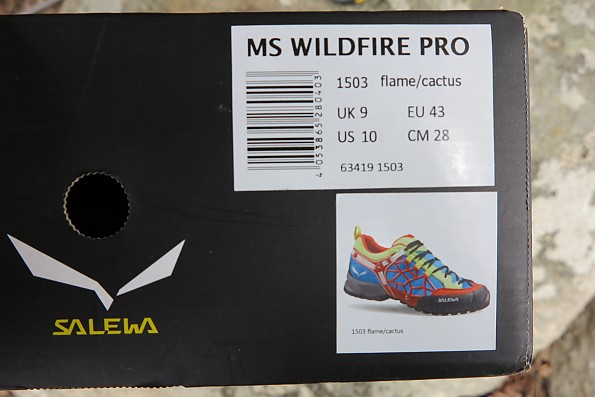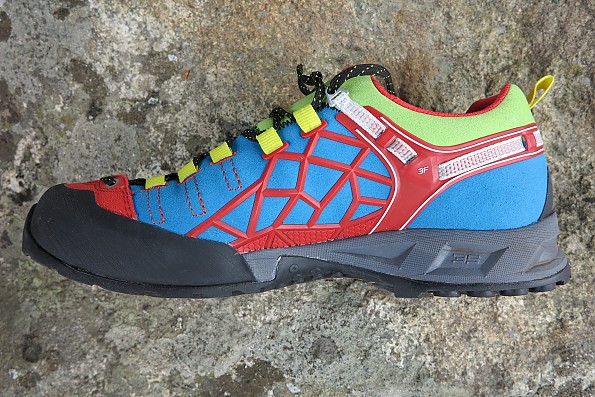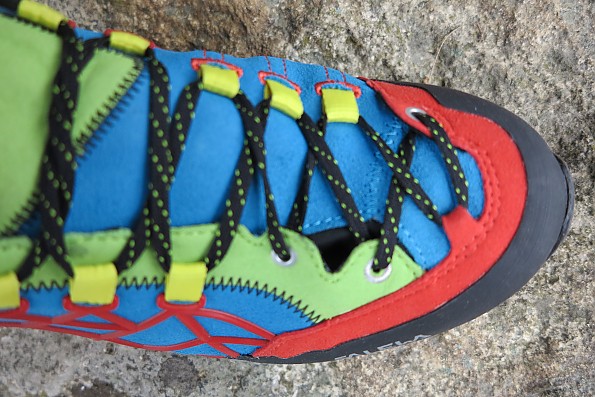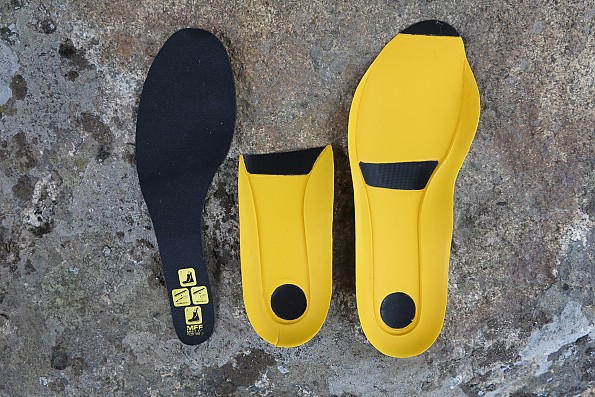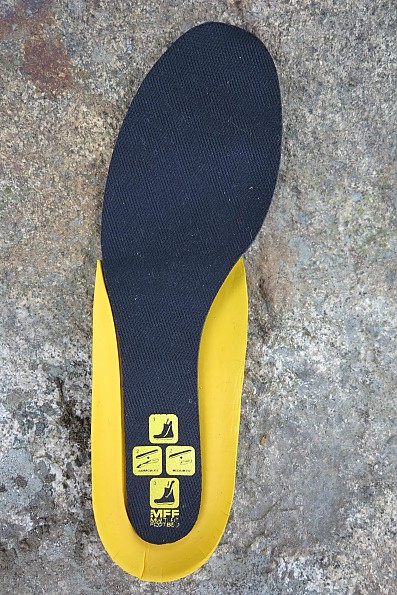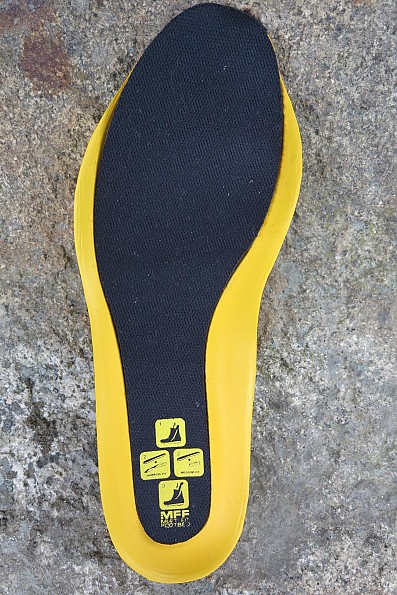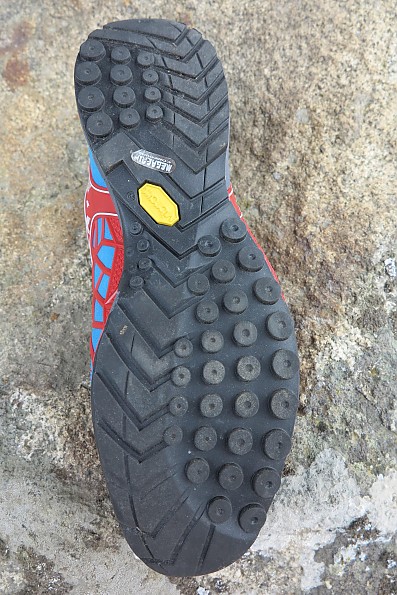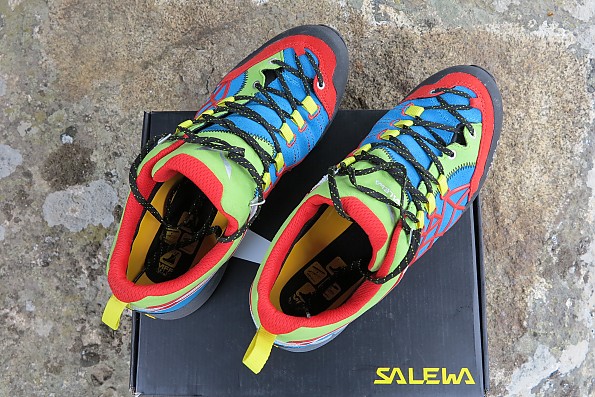Salewa Wildfire Pro
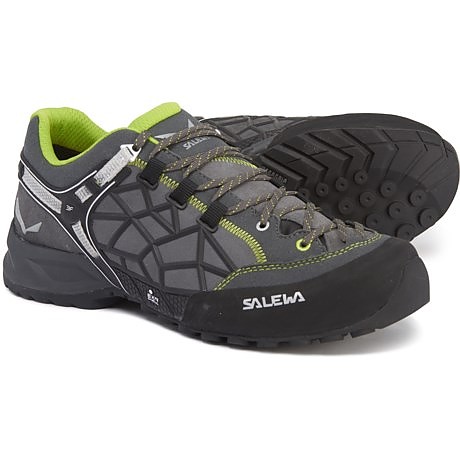
The Salewa Wildfire Pro is, as its name implies, an approach shoe. As such it bridges the gap between a hiking shoe and a climbing shoe. This shoe is the latest iteration of the Wildfire and it truly does hike like a hiking shoe and climb like a climbing shoe.
This shoe is designed to go climbing when you get into an area where you need to go scrambling. It will take you from the parking lot to the summit. Salewa nailed it on this shoe!
Pros
- Climbing lacing is more accurate in the toe area offering more support and greater adjustability
- MFF+ multifit footbed
- Overlap tongue construction for precise, reliable closure
Cons
- Color! (I happen to love it, some don't)
- Laces draw through webbing which might wear out
Recommended Use: Salewa recommends the Wildfire Pro for use on rocky, technical path and I would concur with that assessment. They are excellent hikers, excellent climbers, and work extremely well for backpacking (tested with pack loads up to 25#).
They do not recommend it for mixed mountain environment (snow, ice).
Design: The Wildfire Pro is the second generation of the Wildfire. It comes in a standard version, a Goretex version, a mesh version, and women's version of all three. It features a spherical heel pocket and sculpted arch that were built on a climbing shoe last. From the arch forward it has all the room you’ll need for general hiking performance.
Climbing lacing goes all the way to the toe and allows for more support and performance adjustment. The upper has very little stitching combining midsole, rand, EVO Y frame, and Exa shell together in an injection molded process eliminating glue and stitching and thus weight. It is also equipped with the MFF+ a 3-part multi fit foot bed providing for a customized fit by removing/adding layers to adjust length, width, and height.
The tongue is a sturdy, single piece that allows for reliable, comfortable closure. The Exashell 3D grid enhances containment of the upper and improves forefoot balance. The 3F EVO system provides for precise heel cradling and hold and a guaranteed blister free fit. The sole is Vibram Megagrip, which features 25% more grip without compromising durability and flexibility.
Performance: I wear a size 9 ½ D street shoe and most of my hiking/climbing boots are size 10. The Wildfire in size 10 fits me perfectly. As a reference, I wear Darn Tough full cushion socks but I’ve also used the Darn Toughs in the light cushion and was able to adjust the boot with the lacing system and MFF for a great fit.
The advertised weight is 15.15 oz on one website and 16 oz on a second. My shoes weighed in at 32 ounces for the pair.
The 3F EVO system is common to all Salewa hiking shoes but I’m not sure exactly how the 3F EVO system is supposed to work on these shoes as the vertical leg of the “Y” is sown down to the shoe. Pulling the laces tight merely narrows the gap between the top laces.
This system is supposed to enhance flexibility without hindering support; I don’t find that particularly relevant in a low cut shoe where ankles are already fully free to move and forward flex doesn’t apply. That said, these shoes fit my heel like a glove and there has been absolutely no heel lift the usual cause of blistering.
This photo shows the 3F EVO System, the Exashell 3D grid, and the sticky rubber rand protecting the toe of the shoe
Perhaps my favorite feature is the overlapping one-piece tongue, which is affixed to the inner side of the shoe and overlaps to the outside. It never bunches nor shifts in use and makes for a hassle free lacing/adjusting experience
The climbing lacing system characteristic of approach and climbing shoes runs all the way to the toe and there is a noticeable “V” cutout on the outside aspect of the lacing system between the second and third lace. This ingenious little feature creates a natural break in the shoe when walking at that precise point and allows a nice flex in the forefoot. I wear the laces snug on the forefoot when climbing and considerably looser when on level and uphill trail. I tighten them up significantly for downhill work to avoid the dreaded black toenail.
Climbing Lacing (note the “V” notch in the green portion)
Approach shoes, by design, are a compromise between a hiking shoe and a climbing shoe. These seem to lean a little more to the hiking side of that spectrum with their slightly wider toe boxes but that fits my use for them to a “T.”
I’ve not tried jamming them into cracks to aid in climbing but I have used them to edge while doing third and fourth class climbs using the “climbing zone” of the shoe and they work well for that purpose.
The MFF+ system consists of three parts. The upper part is common to both the wide and narrow settings and is attached with Velcro to either of the selected bottom beds. I prefer the narrow size, which is interesting in that most “alpine” style climbing/approach shoes are quite narrow.
As mentioned above these shoes have fairly wide, comfortable toe box when compared to a lot of approach shoes and that allow for swelling on long hikes. There are no instructions for this system included with shoe – only some small pictures on the foot bed itself. Sales personnel at a local mountain shop had not a clue as to how they were supposed to be setup either. I usually use aftermarket footbeds in my shoes, but in these I much prefer the MFF+ system.
Multi Fit Foot Bed System (MFF+)
MFF+ System in the wide foot (thin sock) configuration
MFF+ System in the narrow foot (thick sock) configuration
The sole is interesting. It is quite sticky but doesn’t seem to wear appreciably more than any other hiking boot. It has a “climbing” edge on the toe and inner aspect of the sole and also contains tread through the arch. It also extends up about an inch to protect the toe of the shoe from wear. It offers tremendous traction on all surfaces.
The only boot I own with better traction is the Salewa Snow Mountain trainer. I suspect the tread on the arch is why these are recommended also for Via Ferrata climbs. (Via Ferrata climbs offer "aids" such as steps, ladders, etc on preset routes). We have some Via Ferrata type stuff at my Fire Department Training Tower and these were quite comfy on those obstacles/aids.
Vibram Megagrip Sole depicting climbing edge and tread in the arch (This is after ~100 miles)
This photo shows the climbing laces, the overlapping (continuous) tongue, and the MFF+ footbed
Testing Conditions: Since these were out of the box comfortable I took them for about a six-mile test drive. The next hike was an 18 mile through hike of the Enchantment Lakes in Washington which consisted of large boulder hopping, scree fields, talus fields, steep ascents, steep descents (some on snow), and lots of tree roots.
I also completed a side trip up McClellen Peak which entailed a good deal of third class and some fourth class climbing, a scree filled gully, a vast field of very large boulders, and a lot of walking/climbing on talus. They proved to be awesome hikers and the best climbing shoes I own – period.
This spring I wore them up to Colchuk Lake on an icy trail carrying a 25# pack and found them to be very stable on wet, slippery rocks and even a wet log or two.
I’ve logged about 300 miles with them and they are still going great showing little signs of serious wear on the soles or uppers. I did no technical rock climbing with these shoes and don’t plan any such climbs in these shoes. For what its worth here's my take on Gortex. Why would you pay almost $40 extra for Gortex shoes that are only 3" tall?
I treated these with Tectron Water Repellant and it works very well to have the shoe shed water but eventually you're going to have water come in over the top. But that's personal opinion. Some people swear by Gortex even in low top shoes, I just don't happen to be one of them.
Conclusion: These have become my go-to shoe for anything not involving deep snow. (When I get into the mixed mountain stuff requiring crampons, gaiters, etc. I switch to La Sportiva Trango Cubes that I’ll review shortly) or Salewa Snow Mountain Trainers.
I highly recommend the Salewa Wildfire Pro for general hiking and backpacking. Their forte however, is scramble hiking and peak bagging. These really shine when the trail ends and scrambling and/or climbing begins.
Their neon blue, red, and yellow color is a turn off to some – I love it. The color is a great conversation starter at Starbucks après climb/hike! I highly recommend these without any reservations!
Source: bought it new
Price Paid: $159 (20% off sale)
Pros
- Fit
- Support
- Quality
Cons
- Price
This shoe is very comfortable, provides good support and traction, while maintaining an attractive appearance.
Source: received it as a personal gift
Your Review
Where to Buy
You May Like
Specs
| Men's | |
|---|---|
| Price |
Historic Range: $43.00-$199.00 Reviewers Paid: $159.00 |
| Women's | |
|---|---|
| Price |
Historic Range: $59.00-$199.00 |


